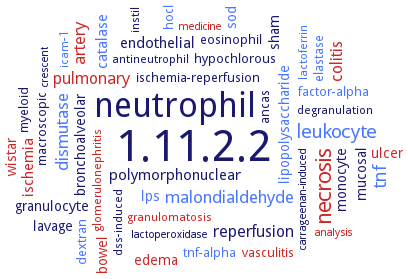1.11.2.2: myeloperoxidase
This is an abbreviated version!
For detailed information about myeloperoxidase, go to the full flat file.

Word Map on EC 1.11.2.2 
-
1.11.2.2
-
neutrophil
-
necrosis
-
leukocyte
-
tnf
-
malondialdehyde
-
dismutase
-
colitis
-
reperfusion
-
pulmonary
-
artery
-
endothelial
-
polymorphonuclear
-
ischemia
-
catalase
-
monocyte
-
sham
-
bowel
-
lps
-
mucosal
-
ulcer
-
edema
-
bronchoalveolar
-
wistar
-
granulocyte
-
lavage
-
lipopolysaccharide
-
sod
-
hypochlorous
-
hocl
-
vasculitis
-
ischemia-reperfusion
-
factor-alpha
-
macroscopic
-
tnf-alpha
-
eosinophil
-
elastase
-
dextran
-
ancas
-
myeloid
-
dss-induced
-
degranulation
-
glomerulonephritis
-
lactoferrin
-
icam-1
-
granulomatosis
-
antineutrophil
-
instil
-
medicine
-
carrageenan-induced
-
lactoperoxidase
-
crescent
-
analysis
- 1.11.2.2
- neutrophil
- necrosis
- leukocyte
- tnf
- malondialdehyde
- dismutase
- colitis
-
reperfusion
- pulmonary
- artery
- endothelial
-
polymorphonuclear
- ischemia
- catalase
- monocyte
-
sham
- bowel
- lps
- mucosal
- ulcer
- edema
-
bronchoalveolar
- wistar
- granulocyte
-
lavage
- lipopolysaccharide
- sod
-
hypochlorous
- hocl
- vasculitis
-
ischemia-reperfusion
- factor-alpha
-
macroscopic
- tnf-alpha
-
eosinophil
- elastase
- dextran
-
ancas
- myeloid
-
dss-induced
-
degranulation
- glomerulonephritis
- lactoferrin
- icam-1
- granulomatosis
-
antineutrophil
-
instil
- medicine
-
carrageenan-induced
- lactoperoxidase
-
crescent
- analysis
Reaction
Synonyms
donor, hydrogen peroxide oxidoreductase, donor, hydrogen peroxideoxidoreductase, donor: H2O2 oxidoreductase, donor:H2O2 oxidoreductase, donor:hydrogen peroxide oxidoreductase, donor:hydrogen-peroxide oxidoreductase, EC 1.11.1.7, epx2a, hemi-MPO, hemi-myeloperoxidase, LPO, MPO, MPX, myeloperoxidase, peroxinectin, properoxinectin, recombinant human MPO, rhMPO, tissue myeloperoxidase
ECTree
Advanced search results
Activating Compound
Activating Compound on EC 1.11.2.2 - myeloperoxidase
Please wait a moment until all data is loaded. This message will disappear when all data is loaded.
5-aminosalicylic acid
-
converts inactive myeloperoxidase compound II rapidly into active myeloperoxidase
betanin
-
low micromolar betanin concentrations enhance the chlorination activity of MPO at pH 7.0, increasing the betanin concentration up to 0.006 mM dramatically increases the chlorination rate of monochlorodimedon
chloride
-
in the presence of 100 mM NaCl the catalytic efficiency of MPO increases 3-4fold whatever the sulfide considered, the rate of 4-tolyl methyl sulphide oxidation enhancement is about 8fold at 120 mM NaCl
D-penicillamine
-
addition of D-penicillamine significantly enhances the rate of chloroacetonitrile oxidation and cyanide release by the myeloperoxidase/H2O2/Cl- system (17.2% increase at 5 mM)
ferrocyanide
-
converts inactive myeloperoxidase compound II into active myeloperoxidase
glutathione
-
addition of glutathione significantly enhances the rate of chloroacetonitrile oxidation and cyanide release by the myeloperoxidase/H2O2/Cl- system (24% increase at 5 mM)
indicaxanthin
-
at neutral pH and depending on their concentration, indicaxanthin can exhibit a stimulating and inhibitory effect on the chlorination activity of MPO
L-cysteine
-
addition of L-cysteine significantly enhances the rate of chloroacetonitrile oxidation and cyanide release by the myeloperoxidase/H2O2/Cl- system (45.4% increase at 5 mM)
myelin oligodendrocyte protein
-
MPO activity increases significantly in the myelin oligodendrocyte protein treated rats (0.05 mg)
-
N-acetyl-L-cysteine
-
addition of N-acetyl-L-cysteine significantly enhances the rate of chloroacetonitrile oxidation and cyanide release by the myeloperoxidase/H2O2/Cl- system (16.3% increase at 5 mM)
serotonin
at low micromolar concentrations (below 0.02 mM), serotonin enhances hypochlorite production by both purified myeloperoxidase and neutrophils
additional information
-
hypercholesterolemia results in higher tissue MPO activities, the influences of fish oil on MPO activities are not obvious in hypercholesterolemic mice with sepsis
-
ascorbic acid
-
converts inactive myeloperoxidase compound II into active myeloperoxidase


 results (
results ( results (
results ( top
top






